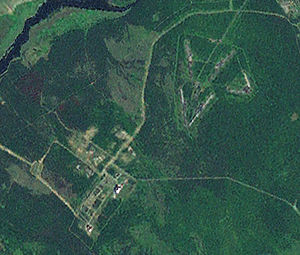Mishelevka Radar Station
| Mishelevka Radar Station | |
|---|---|
| Мишелёвка РЛС | |
| Usolye-Sibirskoye, Irkutsk, Siberia | |

An image of the site from landsat. The 4 Dnestr and 1 Dnepr radars are upper right and the Daryal radar lower left.
|
|
| Coordinates | 52°51′20″N 103°13′54″E / 52.8555°N 103.2317°E |
| Type | Radar Station |
| Code | OS-1 |
| Site information | |
| Owner | Russia |
| Controlled by | Russian Space Forces |
| Open to the public |
no |
| Condition | operational |
| Site history | |
| Built | 1964–2014 |
| Built by | Soviet Union/Russia |
| Garrison information | |
| Garrison | 46th Independent Radio-Technical Unit |
Mishelevka Radar Station is the site of three generations of Soviet and Russian early warning radars. It is located in Irkutsk in Siberia and provides coverage of China and missile launches from submarines in the Pacific Ocean. There have been seven radars at this site and it is run by the Russian Aerospace Defence Forces. In 2012 a new Voronezh-M radar is being built at the site.
Mishelevka is a village in southern Siberia and the station is 4 kilometres (2 mi) east of the village and 28 kilometres (17 mi) northwest of the town of Usolye-Sibirskoye. The military town for the station is called Usolye-Sibirskoye-7 (Russian: Усо́лье-Сиби́рское-7).
Mishelevka was founded as OS-1, a space surveillance site with four Dnestr radar, which were started in 1964 and tested in 1968. It could detect satellites at an altitude of up to 3,000 kilometres (1,864 mi).
In 1967-8 a Dnepr early warning radar was started adjacent to the 4 Dnestr radars and it was commissioned in 1976.
One of the Dnestr space surveillance radars is now used as an incoherent scatter radar by the Institute of Solar-Terrestrial Physics, part of the Russian Academy of Sciences.
Mishelevka had a Daryal-U radar, a bistatic phased-array early warning radar consisting of two separate large phased-array antennas separated by around 500 metres (1,640 ft) to 1.5 kilometres (4,921 ft). The transmitter array was 30 by 40 metres (98 ft × 131 ft) and the receiver was 80 by 80 metres (260 ft × 260 ft) in size. The system is a VHF system operating at a wavelength of 1.5 to 2 meters (150 to 200 MHz). The claimed range of a Daryal installation is 6,000 kilometres (3,728 mi).
...
Wikipedia

